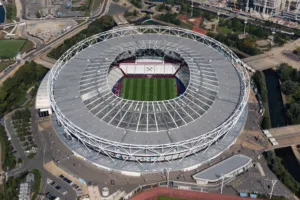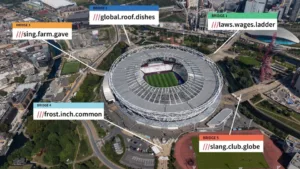London Stadium: Home of West Ham United and the 2012 Olympics
London Stadium is a multi-purpose outdoor stadium located in the Stratford district of London. It was originally built to host the 2012 Olympic and Paralympic Games and has since become a popular venue for sports, music, and entertainment events. The stadium has a seating capacity of 80,000 and is owned by the London Legacy Development Corporation.
The stadium’s design and architecture were created by architect firm Populous, who aimed to create a venue that could host a variety of events beyond the Olympics. The stadium’s most distinctive feature is its retractable roof, which can be opened or closed depending on the weather. The stadium also features a running track, which can be covered by a removable synthetic surface to create a larger event space.
Key Takeaways
- London Stadium is a multi-purpose outdoor stadium located in the Stratford district of London, originally built for the 2012 Olympic and Paralympic Games.
- The stadium’s design and architecture were created by Populous, featuring a retractable roof and a removable synthetic surface for the running track.
- London Stadium is a popular venue for sports, music, and entertainment events, with a seating capacity of 80,000.
London Stadium History

Construction
London Stadium, formerly known as the Olympic Stadium, was constructed specifically for the 2012 Summer Olympics and Paralympics. The stadium is located in the Lower Lea Valley, 6 miles (10 km) east of central London. The construction of the stadium was completed in March 2011, and it was officially opened in April 2012. The stadium was designed by Populous, a global architectural firm. The construction of the stadium cost around £486 million.
Opening Ceremony
The opening ceremony of the London 2012 Olympics was held on 27 July 2012 at the London Stadium. The ceremony was directed by Danny Boyle and featured a number of performances and presentations that showcased British history and culture. The ceremony was watched by an estimated 900 million people worldwide.
Major Events
Since the completion of the 2012 Summer Olympics, the London Stadium has hosted a number of major sporting and cultural events. In 2015, the stadium hosted five matches of the Rugby World Cup, including the bronze medal match. In 2017, the stadium hosted the World Athletics Championships, which saw the world’s best athletes compete in a variety of track and field events. The stadium is also the home ground of West Ham United FC, a Premier League football club. The club moved to the stadium in 2016, and it has a capacity of 60,000 spectators.
Design and Architecture

Stadium Structure
The London Stadium, located in London, England, is an iconic football stadium known for its impressive design and architecture. Designed by renowned architects and boasting notable features, the stadium stands as a symbol of excellence in sports infrastructure. The stadium, previously known as the Olympic Stadium, was built for the 2012 Summer Olympics and Paralympics. The stadium’s structure is unique and was designed to be a multi-purpose venue. The stadium has a distinctive bowl shape, with a cantilever roof that covers all the seating areas.
Seating Capacity
The stadium has a seating capacity of 80,000, making it the third-largest stadium in the United Kingdom. The stadium’s seating bowl is compact, bringing the spectators closer to the action on the field. The stadium’s design ensures that every spectator has an unobstructed view of the field. The stadium’s seating capacity can be reduced to 60,000 for athletics events and concerts.
Sustainability Features
The London Stadium is a sustainable venue that features several environmentally friendly features. The stadium’s roof is made of lightweight materials, reducing the amount of steel required for its construction. The stadium also features a rainwater harvesting system that collects rainwater and uses it to irrigate the pitch. The stadium’s lighting system is energy-efficient, reducing the stadium’s energy consumption. Additionally, the stadium’s waste management system ensures that waste is disposed of in an environmentally friendly manner.
In summary, the London Stadium is an impressive sports venue with a unique design and notable features. The stadium’s seating capacity, sustainable features, and compact seating bowl make it a popular venue for sports events and concerts.
Location and Accessibility

London Stadium is a multi-purpose outdoor stadium located in the Stratford district of London. It is situated in the Lower Lea Valley, approximately 6 miles (10 km) east of central London. The stadium was specifically constructed for the 2012 Summer Olympics and 2012 Summer Paralympics. Since then, it has been used for a variety of sporting and musical events.
Public Transportation
London Stadium is easily accessible via public transportation. The stadium is well-connected to the London Underground, Overground, and DLR networks. The nearest Underground station is Stratford, which is served by the Central and Jubilee lines. From there, visitors can take a short walk to the stadium or transfer to the DLR for direct access to the stadium.
In addition to the Underground and DLR, visitors can also take buses or trains to Stratford station. There are several bus routes that stop near the stadium, including the 25, 86, and 308. National Rail services also run to Stratford station from various locations in London and beyond.
Parking Facilities
London Stadium has limited parking facilities, and visitors are encouraged to use public transportation whenever possible. However, there are a few parking options available for those who need to drive. The closest car park to the stadium is the Westfield Stratford City Car Park, which is located just a short walk away. There are also a few other car parks in the surrounding area, including the Stratford International Car Park and the Stratford Centre Car Park.
Visitors with disabilities can park in designated accessible parking bays located close to the stadium. These bays require a valid Blue Badge and must be booked in advance through the stadium’s accessibility team.
Overall, London Stadium is easily accessible via public transportation and offers limited parking options for those who need to drive. Visitors are encouraged to plan ahead and use public transportation whenever possible to avoid traffic congestion and parking difficulties.
Events and Usage

London Stadium, located in the Stratford district of London, is a multi-purpose outdoor stadium that has been used for various events since its construction for the 2012 Summer Olympics and Paralympics. The stadium is now a popular venue for sports events, concerts, and community activities.
Sports Events
London Stadium has hosted several sports events, including football, athletics, and baseball. The stadium is the home of West Ham United Football Club, which moved to the stadium in 2016. The stadium has also hosted the 2017 IAAF World Championships and will be the host of the MLB London Series in 2024, featuring the New York Mets and the Philadelphia Phillies.
Concerts and Shows
London Stadium has also hosted several concerts and shows featuring world-renowned artists. In 2018, the stadium hosted a concert by the Rolling Stones, which was attended by over 70,000 people. Other notable artists who have performed at the stadium include Beyoncé, Ed Sheeran, and Foo Fighters.
Community Use
London Stadium is not only used for sports and entertainment events but also for community activities. The stadium has hosted several events, including charity runs, festivals, and community sports days. The stadium also offers guided tours that allow visitors to explore the venue and learn about its history and legacy.
In conclusion, London Stadium is a versatile venue that has hosted a variety of events since its construction. From sports events to concerts and community activities, the stadium has become a popular destination for people of all ages and interests.
Economic Impact

London Stadium has had a significant economic impact on the local economy since its opening. The stadium has been a major contributor to the local economy and has created several employment opportunities for the residents of the area.
Local Economy
According to a report by Football.london, the stadium contributes around £900m of gross output to London’s economy, generating an additional GVA (gross value added to the economy) of nearly £500m in the capital. The stadium has been a catalyst for the regeneration of the area and has attracted several businesses to the area, which has boosted the local economy.
Employment Opportunities
The stadium has created several employment opportunities for the residents of the area. According to a report by ESSMA, the economic impact of the stadium arises in part from onsite stadium activity, with over 200 full-time equivalent jobs supported onsite. The stadium has also created several indirect employment opportunities in the area, such as hospitality and tourism.
Overall, London Stadium has had a positive economic impact on the local economy and has created several employment opportunities for the residents of the area.
Ownership and Management
London Stadium is owned by E20 Stadium LLP, which is a joint venture between the London Legacy Development Corporation (LLDC) and the Mayor of London’s office. The stadium was built for the 2012 Summer Olympics and Paralympics and was converted into a multi-use venue after the games.
The day-to-day management of the stadium was initially handled by VINCI Stadium, through its subsidiary London Stadium 185. However, in January 2019, E20 agreed to take over the management of the stadium and bring it in-house.
West Ham United Football Club has been the anchor tenant of the stadium since 2016, playing their home matches at the venue. The club’s move to the stadium was not without controversy, with legal disputes arising over the terms of the lease and the cost of converting the stadium for football use.
London Stadium has also hosted a variety of other events, including concerts, athletics meets, and Major League Baseball games. The stadium has a seating capacity of 60,000 for football matches and can be expanded to 80,000 for concerts and other events.
Overall, the ownership and management of London Stadium have undergone several changes since the venue was built for the 2012 Olympics. Despite some initial challenges, the stadium has become a popular venue for sports and entertainment events in London.
Other Stadiums Articles:
Check Out: Villa Park Stadium: A Historic Venue for Football Fans
Check Out: St James’ Park Stadium: Home of Newcastle United Football Club
Check Out: The Amex Stadium: A Comprehensive Guide
Check Out: St Mary’s Stadium: Home of Southampton FC
Check Out: Cape Town Stadium: A Modern Icon in South Africa
Tags: Home of West Ham United, London Stadium, London Stadium Design and Architecture, London Stadium Events and Usage, London Stadium History, London Stadium Location and Accessibility